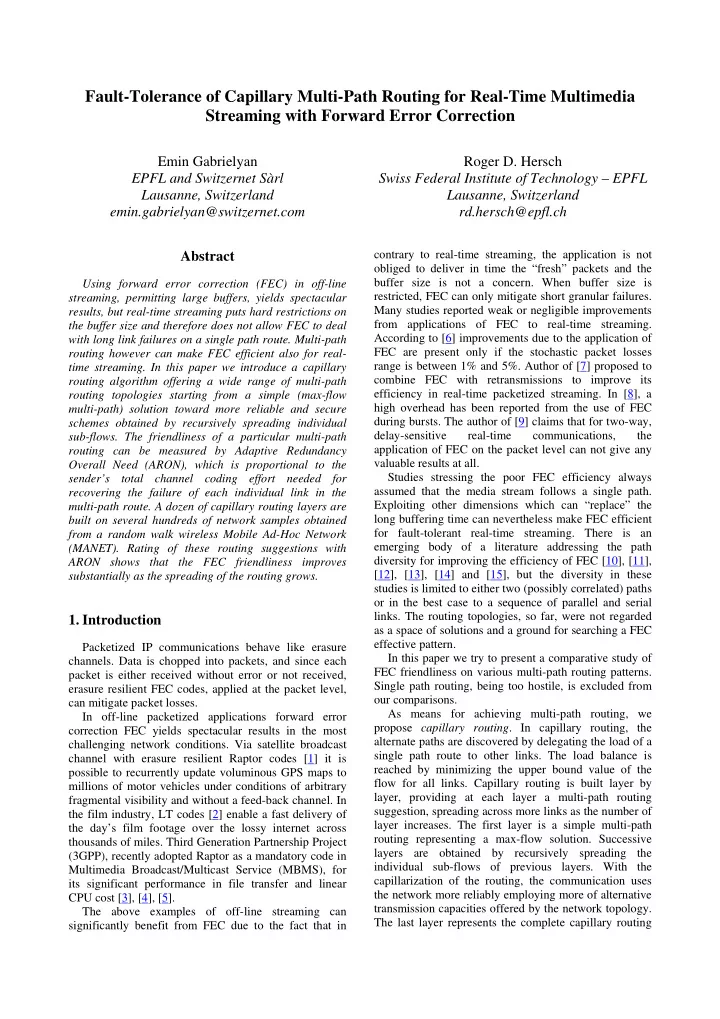

Fault-Tolerance of Capillary Multi-Path Routing for Real-Time Multimedia Streaming with Forward Error Correction Emin Gabrielyan Roger D. Hersch EPFL and Switzernet Sàrl Swiss Federal Institute of Technology – EPFL Lausanne, Switzerland Lausanne, Switzerland emin.gabrielyan@switzernet.com rd.hersch@epfl.ch contrary to real-time streaming, the application is not Abstract obliged to deliver in time the “fresh” packets and the buffer size is not a concern. When buffer size is Using forward error correction (FEC) in off-line restricted, FEC can only mitigate short granular failures. streaming, permitting large buffers, yields spectacular Many studies reported weak or negligible improvements results, but real-time streaming puts hard restrictions on from applications of FEC to real-time streaming. the buffer size and therefore does not allow FEC to deal According to [6] improvements due to the application of with long link failures on a single path route. Multi-path FEC are present only if the stochastic packet losses routing however can make FEC efficient also for real- range is between 1% and 5%. Author of [7] proposed to time streaming. In this paper we introduce a capillary combine FEC with retransmissions to improve its routing algorithm offering a wide range of multi-path efficiency in real-time packetized streaming. In [8], a routing topologies starting from a simple (max-flow high overhead has been reported from the use of FEC multi-path) solution toward more reliable and secure during bursts. The author of [9] claims that for two-way, schemes obtained by recursively spreading individual delay-sensitive real-time communications, the sub-flows. The friendliness of a particular multi-path application of FEC on the packet level can not give any routing can be measured by Adaptive Redundancy valuable results at all. Overall Need (ARON), which is proportional to the Studies stressing the poor FEC efficiency always sender’s total channel coding effort needed for assumed that the media stream follows a single path. recovering the failure of each individual link in the Exploiting other dimensions which can “replace” the multi-path route. A dozen of capillary routing layers are long buffering time can nevertheless make FEC efficient built on several hundreds of network samples obtained for fault-tolerant real-time streaming. There is an from a random walk wireless Mobile Ad-Hoc Network emerging body of a literature addressing the path (MANET). Rating of these routing suggestions with diversity for improving the efficiency of FEC [10], [11], ARON shows that the FEC friendliness improves [12], [13], [14] and [15], but the diversity in these substantially as the spreading of the routing grows. studies is limited to either two (possibly correlated) paths or in the best case to a sequence of parallel and serial links. The routing topologies, so far, were not regarded 1. Introduction as a space of solutions and a ground for searching a FEC effective pattern. Packetized IP communications behave like erasure In this paper we try to present a comparative study of channels. Data is chopped into packets, and since each FEC friendliness on various multi-path routing patterns. packet is either received without error or not received, Single path routing, being too hostile, is excluded from erasure resilient FEC codes, applied at the packet level, our comparisons. can mitigate packet losses. As means for achieving multi-path routing, we In off-line packetized applications forward error propose capillary routing . In capillary routing, the correction FEC yields spectacular results in the most alternate paths are discovered by delegating the load of a challenging network conditions. Via satellite broadcast single path route to other links. The load balance is channel with erasure resilient Raptor codes [1] it is reached by minimizing the upper bound value of the possible to recurrently update voluminous GPS maps to flow for all links. Capillary routing is built layer by millions of motor vehicles under conditions of arbitrary layer, providing at each layer a multi-path routing fragmental visibility and without a feed-back channel. In suggestion, spreading across more links as the number of the film industry, LT codes [2] enable a fast delivery of layer increases. The first layer is a simple multi-path the day’s film footage over the lossy internet across routing representing a max-flow solution. Successive thousands of miles. Third Generation Partnership Project layers are obtained by recursively spreading the (3GPP), recently adopted Raptor as a mandatory code in individual sub-flows of previous layers. With the Multimedia Broadcast/Multicast Service (MBMS), for capillarization of the routing, the communication uses its significant performance in file transfer and linear the network more reliably employing more of alternative CPU cost [3], [4], [5]. transmission capacities offered by the network topology. The above examples of off-line streaming can The last layer represents the complete capillary routing significantly benefit from FEC due to the fact that in
Recommend
More recommend